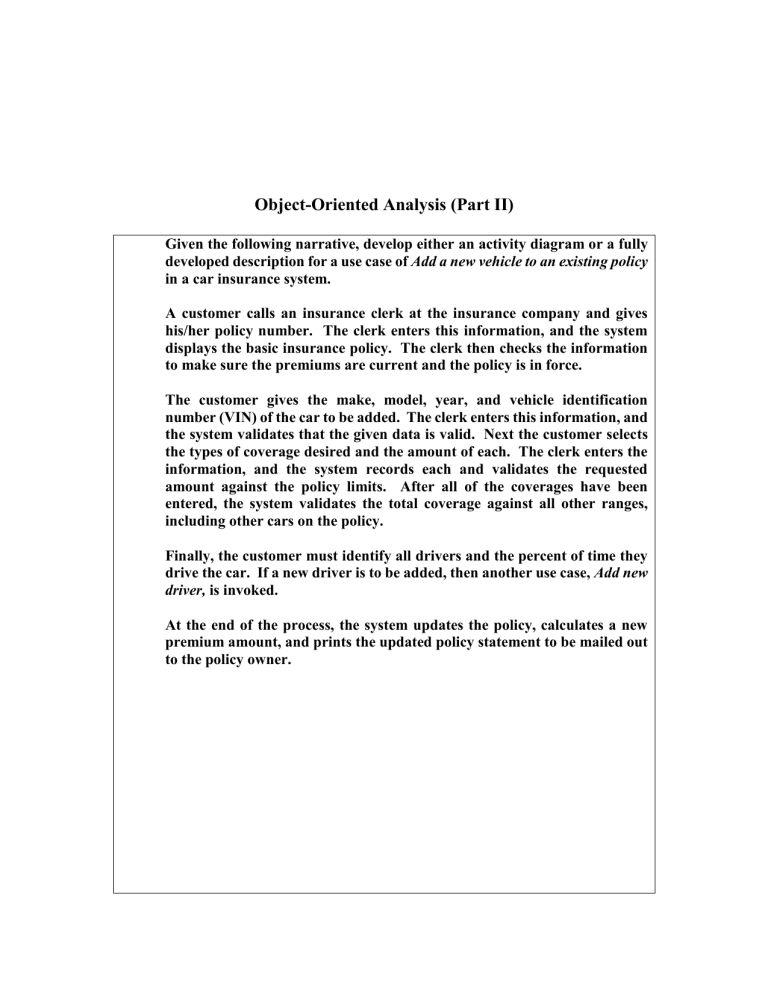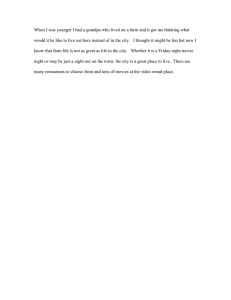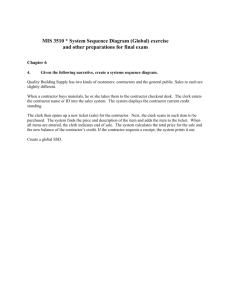
Object-Oriented Analysis (Part II) Given the following narrative, develop either an activity diagram or a fully developed description for a use case of Add a new vehicle to an existing policy in a car insurance system. A customer calls an insurance clerk at the insurance company and gives his/her policy number. The clerk enters this information, and the system displays the basic insurance policy. The clerk then checks the information to make sure the premiums are current and the policy is in force. The customer gives the make, model, year, and vehicle identification number (VIN) of the car to be added. The clerk enters this information, and the system validates that the given data is valid. Next the customer selects the types of coverage desired and the amount of each. The clerk enters the information, and the system records each and validates the requested amount against the policy limits. After all of the coverages have been entered, the system validates the total coverage against all other ranges, including other cars on the policy. Finally, the customer must identify all drivers and the percent of time they drive the car. If a new driver is to be added, then another use case, Add new driver, is invoked. At the end of the process, the system updates the policy, calculates a new premium amount, and prints the updated policy statement to be mailed out to the policy owner. Use Case Name: Scenario: Triggering Event: Brief Description: Actors: Stakeholders: Preconditions: Postconditions: Flow of Events: Actor Exception Conditions: . System Case Study: DownTown Video Rental System DownTown Videos is a chain of 11 video stores scattered throughout a major metropolitan area in the Midwest. The chain started with a single store several years ago and has grown to its present size. Paul Lowes, the owner of the chain, knows that to compete with the national chains will require a state-of-the-art movie rental system. You have been asked to develop the system requirements for the new system. Each store has a stock of movies and video games for rent. It is important to keep track of each movie title to know and to identify its category (classical, drama, comedy, and so on), its rental type (new release, standard), movie rating, and other general information such as movie producer, release date, cost, and so forth. In addition to tracking each title, the business must track each individual copy to note its purchase date, its condition, and its rental status. User functions must be provided to maintain this inventory information. Customers, the lifeblood of the business, are also tracked. DownTown considers each family to be a customer, so special mailings and promotions are offered to each household. For any given customer, several people may be authorized to rent videos and games. The primary contact for each customer can also establish rental parameters for other members of the household. For example, if a parent wants to limit a child’s rental authorization to only PG and PG-13 movies, the system will track that. Each time a movie is rented, the system must keep track of which copies of which movies and games are rented; the rental date and time and the return date and time; and the household and person renting the movie. Each rental is considered to be open until all of the movies and games have been returned. Customers pay for rentals when checking out videos at the store. For this case, develop the following diagrams: 1. A class diagram. 2. A use case diagram. 3. An activity diagram for each of the use cases having to do with renting and checking in movies and for the use cases to maintain customer and family member information. 4. A system sequence diagram for each of the use cases from problem 2 5. A statechart identifying the possible states (status conditions) for a physical copy of a movie, based on the case descriptions given previously and your knowledge of how a video store might work.





